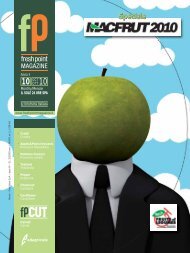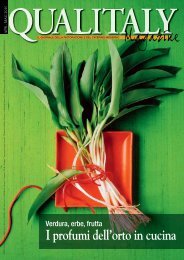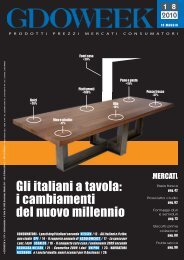Fresh Point Magazine - B2B24 - Il Sole 24 Ore
Fresh Point Magazine - B2B24 - Il Sole 24 Ore
Fresh Point Magazine - B2B24 - Il Sole 24 Ore
You also want an ePaper? Increase the reach of your titles
YUMPU automatically turns print PDFs into web optimized ePapers that Google loves.
product/apples<br />
prodotto/mele<br />
What volumes do<br />
you produce and<br />
who takes care<br />
of post-harvest<br />
handling?<br />
The valley’s crop is<br />
now approaching<br />
40 tons, or 2% of<br />
the national total.<br />
Nearly 80% of the<br />
apples grown here<br />
are taken for postharvest<br />
handling<br />
and marketing to<br />
Melavì, a Producer<br />
Organisation<br />
recognised by the EU Commission.<br />
How many growers are members?<br />
We about have about 600 small-plot producers with<br />
an average orchard size of about one hectare. These<br />
orchards are also highly fragmented in small plots of<br />
2000 square metres.<br />
What varieties do you grow?<br />
The most popular cultivars are Stark Delicious,<br />
Golden Delicious and Gala, all of which are historically<br />
traditional here and earned us the EU’s Pgi quality<br />
seal in March 2010. One of the latest cultivars to be<br />
introduced is Fuji, which like all red varieties has<br />
found favourable soil and climate here. When it<br />
comes to introducing new varieties and crop management<br />
techniques, our extension agents collaborate<br />
with their counterparts and research centres in<br />
Lombardy and Trent-South Tyrol.<br />
Have you got your own orchard guidelines?<br />
Valtellina orchards adopted more than twenty years<br />
ago a code of integrated fruit crop production standards<br />
that was drawn up jointly with Sondrio provincial<br />
and Lombardy regional authorities. So, all our orchards<br />
are managed under IP criteria, which call for continuous<br />
monitoring of plant development stage and logging<br />
of weather data, as well as the use of traps to detect<br />
the presence of the most harmful pests.<br />
What kind of crop are you seeing this year?<br />
We’ve got considerable volume but also, and unfortunately,<br />
hail damaged nearly 30% of the crop and that<br />
part will go to processors. Melavì has already begun<br />
making apple juice but certainly won’t be able to handle<br />
a volume as big as that.<br />
What are your key markets?<br />
The biggest market for Melavì is Lombardy, where we<br />
sell nearly 50% of our crop, followed by the 37% we<br />
38 <strong>Fresh</strong> <strong>Point</strong> <strong>Magazine</strong> n.11 – november/novembre 2011<br />
Quali sono i volumi<br />
di produzione e<br />
dove avviene il<br />
conferimento?<br />
La produzione si<br />
avvicina ai 400mila<br />
quintali (il 2% di<br />
quella nazionale) e<br />
circa l’80% delle<br />
mele prodotte in<br />
Valtellina viene conferito<br />
e commercializzato<br />
da Melavì che<br />
è un’organizzazione<br />
di produttori riconosciuta<br />
dalla CE.<br />
Quanti sono i produttori?<br />
Sono circa 600 con ridotte dimensioni aziendali e una<br />
superficie media attorno all’ettaro: le aziende si caratterizzano<br />
anche per l’elevata frammentazione degli<br />
appezzamenti di piccole dimensioni (2000 mq).<br />
Quali le varietà coltivate?<br />
Le cultivar maggiormente coltivate sono la Stark<br />
Delicious, la Golden Delicious e la Gala (varietà storiche<br />
per cui la Valtellina ha ottenuto nel marzo 2010 il riconoscimento<br />
europeo mela di Valtellina Igp). Ultimamente è<br />
stata introdotta anche la Fuji che, come tutte le varietà<br />
rosse, ha trovato nel nostro territorio terreno e clima<br />
favorevole. Per quanto riguarda il rinnovo varietale e le<br />
tecniche di coltivazione, i nostri tecnici collaborano con<br />
i tecnici e gli istituti di ricerca della Lombardia e del<br />
Trentino Alto Adige.<br />
Avete un regolamento di autodisciplina?<br />
Da più di vent’anni le aziende valtellinesi adottano il<br />
regolamento di autodisciplina per la produzione integrata<br />
in frutticoltura, redatto in collaborazione con la<br />
Provincia di Sondrio e la Regione Lombardia. La gestione<br />
dei frutteti avviene secondo i principi della lotta integrata<br />
che si basa su continui rilievi fenologici, meteorologici<br />
e l’utilizzo di trappole per il monitoraggio della presenza<br />
degli insetti più dannosi.<br />
Com’è la produzione quest’anno?<br />
È quantitativamente notevole ma, purtroppo, in parte<br />
(circa il 30%) è stata rovinata dalla grandine e dovrà<br />
essere destinata all’industria. Melavì ha iniziato la produzione<br />
di succo di mela, ma in misura che non potrà sicuramente<br />
assorbire un così grande quantitativo.<br />
Quali i mercati più importanti?<br />
<strong>Il</strong> mercato più importante per Melavì è quello lombardo<br />
che assorbe circa il 50% della produzione, mentre il<br />
37% raggiunge i più importanti centri del centro e nord
















